The 350th Anniversary of the Battle of Seneffe

A monument to the battle at the Castle of Seneffe. (Photo by Matthew James)
Three hundred and fifty years ago, Daniel Greysolon Sieur du Luth first met Father Louis Hennepin in the aftermath of the Battle of Seneffe. While this battle is often listed as a footnote in the history of French colonialism in Minnesota, it was one of the most significant battles of the Franco-Dutch War. On Aug. 11, 1674, French troops fought in southern Belgium against an allied army of Dutch, German and Spanish soldiers. The battle shaped European history and the meeting of Du Luth and Hennepin at the site of that battle led to a story that, while almost certainly false, endures as one the foundational tales of Minnesota history.
Between 1672 and 1679, France fought against the Dutch Republic and its allies in order to take control of the Netherlands. At the end of the war, the Netherlands remained independent but France gained territory in a peace treaty that largely defined the current northern border of France. Within this years-long conflict, the Battle of Seneffe remains one of the most memorable battles of the war, one in which two renowned generals fought to a stalemate that left a total of 20,000 soldiers dead.
The town of Seneffe currently has a population of around 10,000. When I visited last month, a van with a speaker circled around announcing the arrival of the traveling circus for the entire time I was there. The English Wikipedia page only lists two events of note in the history of Seneffe: the closing of a car assembly plant in 1982 and the Battle of Seneffe in 1674.
Even 350 years later, it’s not a surprise that the battle is still remembered. A lot of notable people were there. The French army was led by Louis II de Bourbon, Prince of Condé, also known as le Grand Condé, considered one the greatest French generals of all time. During the Thirty Years War, a conflict between 1618 and 1648 between multiple European powers, his brilliance on the battlefield shifted the balance of power in Europe to France. The Battle of Seneffe, which he fought at the age of 53, is considered his last great battle. His descendants include the current kings of Spain and Belgium.
The Allies were led by William III, not only the leader of the Dutch Republic at the time of the battle but for the last 13 years of his life, the King of England. As King of England, he commanded his troops into battle against France on multiple occasions and became known as a great military tactician himself. At the time of the Battle of Seneffe, he was only 23. He died childless, but as the great-grandson of William the Silent, the Dutch leader who gained the country’s independence from Spain in the 16th century, he belongs to the same family line as the current Dutch monarchy.

A plaque on the monument at the Castle of Seneffe states the date of the battle and the two famous generals who fought against each other in it. (Photo by Matthew James)
These two leaders already had renown in Europe. But amongst the French troops were two other men who would later become known in Europe through reports of their travels to the area that would become Minnesota. At the time of the battle, Daniel Greysolon Sieur du Luth had already been living in the territories of New France and had returned to his country of birth on family business when, as a member of an elite military regiment made up of noblemen known as the Gendarmes, he found himself drawn in to the Franco-Dutch war. Du Luth was just two degrees separated from the great French general. At the Battle of Seneffe, he served as a squire to Marquis de Lassay, a military advisor who reported directly to Condé.
Prior to the Franco-Dutch war, Louis Hennepin had been travelling around Europe, visiting the holy sites of Italy and Germany after having become ordained as priest. He stayed in Halle, Belgium, for a year serving as a priest at the city’s convent (his convent was recently remodeled into a senior living facility with rents starting at just € 1,559/month) but longed to continue traveling. He managed a transfer to the port city of Calais where he took great pleasure in hearing the stories of sailors who had returned from across the Atlantic. He then became a missionary in the Netherlands. While living in the southern Dutch city of Maastricht, he began to attend to the sick and wounded soldiers of the Franco-Dutch war, a task he was well suited for as he spoke both French and Dutch. After nearly dying of spotted fever and dysentery, he began to travel to the battle sites of the war in order to administer sacraments to wounded soldiers, which is how he found himself in Seneffe in August 1674.
The Battle of Seneffe wasn’t supposed to be a battle at all, as I learned when I stopped by the Seneffe public library. I thought it would be at least worthwhile to ask if they had a book that might have a paragraph or two about the battle that I could use for this post. A library worker brought me down to the basement and placed two enormous binders in front of me. They seemed to have been compiled in the 1970s as part of commemoration of the 300th anniversary of the battle.
The binders were filled with copies of paintings, maps, biographies and historical accounts that described the battle in a level of detail far greater than necessary here. What follows is a very condensed account based largely on the Wikipedia page but informed by material from the binders and my time visiting the present day sites.
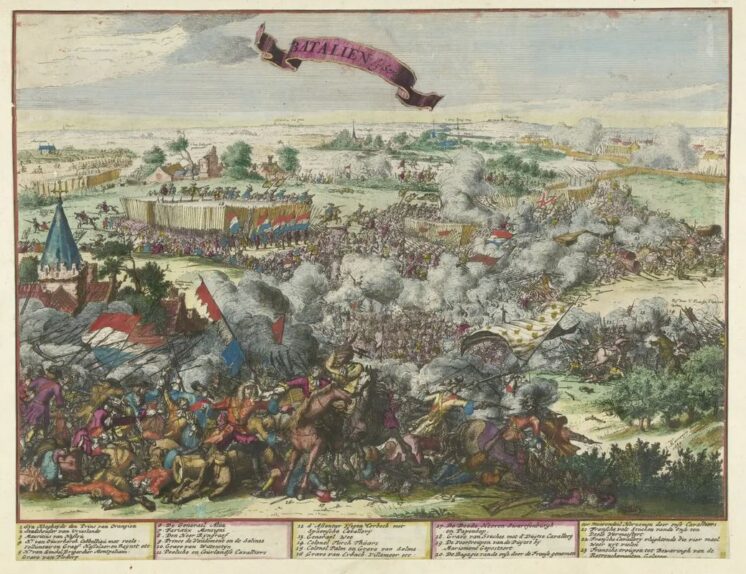
A drawing of The Battle of Seneffe made by Jacobus Harrewijn and Romeyn de Hooghe in 1684.
The battle began when the Dutch army and its allies decided to march past the French army in order to attack towns within France. The French general had cleverly positioned his army in a field where a small brook made a u-turn, protecting his troops on three sides but limiting the mobility of his army. The Allies thought they could march by with little risk of a battle. The French general, however, noticed that the allies weren’t so allied. The columns of soldiers from different countries were poorly coordinated, creating large gaps. The French general realized he could attack these small groups with fast moving cavalry with little opposition. At 10 a.m. on Aug. 11, 1674, he cleared away all of the troops between his army and the town of Seneffe.

Left: A map showing the location of French troops at the battle. The encampment of the French troops is shown in blue at the lower left. Right: A satellite view of the present day location. In both maps, north is to the right and corresponding towns are circled.
While there was considerably more resistance in Seneffe, the French general used the territory he had just taken control of with his cavalry to bring his infantry into motion and capture the town. The Allied cavalry retreated against orders in the confusion that followed, and the French general thought he was on his way to decisive victory. The Dutch general, however, understood the danger as much as the French general saw the opportunity, and moved as many troops as possible to the west, into a hilly area just outside of town criss-crossed with hedges. The two groups fought with heavy losses on both sides until the Allies again fell back, quickly fortifying their position in the small settlement of St. Nicoals with a concentration of troops. The French attacked again, driving the allies out of St. Nicolas at two in the afternoon but again with heavy losses.
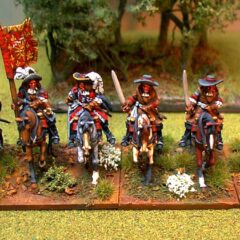
Reenactments of the battle remain popular with miniaturists because of the colorful uniforms worn on both sides (Photo by P.J. Walke)
The Allies quickly moved into an even more defensible position, a large village filled with orchard fields, each surrounded by hedges. Swampy marsh land bordered the village on two sides, meaning the French had limited areas to approach and had to fight for each field. The rough obstacle-filled terrain made it impossible for the French to make a co-ordinated, unified attack, but the French general, feeling confident after the victories earlier in the day, still tried. The battle went on for hours, into the night, with no clear victory on either side.
At 11 p.m., both sides stopped fighting but neither fully retreated. The French general ordered his troops to stay on the battlefield in order to resume the fight in the morning. Somewhere around midnight, a musket shot rang out for reasons that remain unknown. A small clash began in the middle of the night, resulting in chaos and confusion within a weakened French army. The commotion died down, but it made the French general realize the real possibiity of a loss the next day, a loss that would provide an open path for the Allies to invade France. He began moving his troops off of the battlefield. The Allies themselves were also wary of further conflict after such heavy losses, and took the exit from the battlefield by the French as an opportunity to retreat themselves. They briefly celebrated a largely symbolic retaking of Seneffe before marching on to a stronghold to the west. The French general moved his troops back to the secure position where they had started the day.
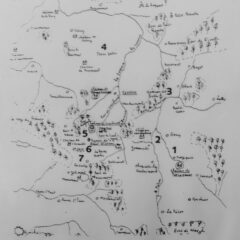
A map showing the position of French troops during the day (map courtesy of the Seneffe Public Library).
And that would be where Daniel Greysolon Sieur du Luth and Louis Hennepin first found themselves in the same place at the same time. It makes sense that upon meeting they would become friends. They were both members of the Recollets, a branch of the Franciscans. Daniel had been a lifelong member, with a Recollet monastery a short walk from his childhood home. Louis was a Recollet priest. The house where he was born in Ath, Belgium still stands on a street now named after his family. The street that connects to it is Rue des Recollets.
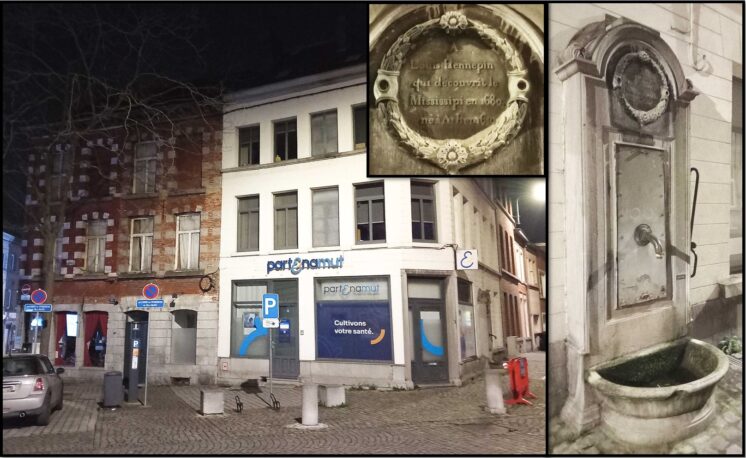
Hennepin’s childhood home in Ath, Belgium. A commemorative well on the side of house contains the inscription, “To Louis Hennepin who discovered the Mississippi in 1680, born in Ath in 1620.” Europeans had known of the Mississippi since 1541, indigenous people for considerably longer. Also he wasn’t born in 1620. (Photos by Matthew James)
As much as their shared religious affiliation, the two men had a common interest: the French colonies. Sieur du Luth had already made two trips across the ocean. He had a wife waiting for him back in Montreal. Louis Hennepin had a strong desire to travel, even though at that particular moment he was not very far from home. The city of Ath, just 25 miles away from Seneffe, was the one of the main supply sites for the French army in the period surrounding the battle.
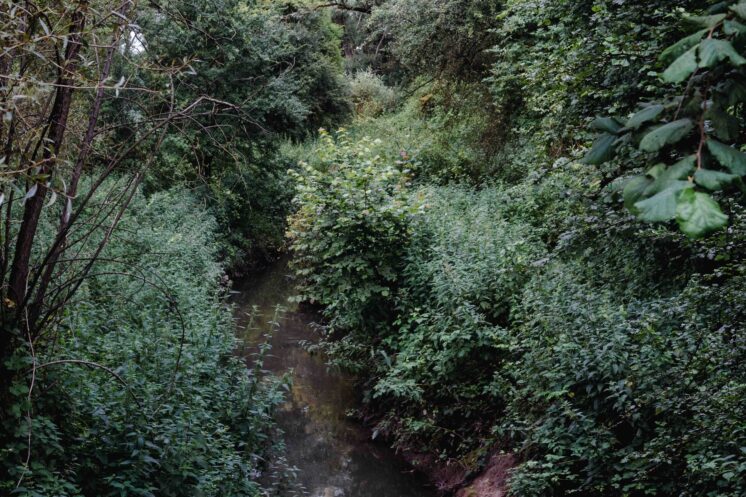
The shallow brook near the likely location where Hennepin and Du Luth first met. (photo by Matthew James)
Less than a year later, Hennepin finally realized his desire to travel to New France, arriving in Quebec City on June 16, 1675. Five years later, he would meet Daniel Greysolon once again in the area that would later become Minnesota. As told by the Canadian Museum of History, Hennepin was kidnapped by members of the Dakota tribe during the spring of 1680. And this is where the Battle of Seneffe is often inserted as a footnote in Minnesota history. Hearing of his kidnapping and knowing Hennepin from the battle six years earlier, Daniel Greysolon abandons his search for a western sea and comes to the rescue of Hennepin, freeing him from his captors.
Accounts of this kidnapping and daring rescue can still be found in a number of accounts of French colonial history in Minnesota. In North Country: The Making of Minnesota, Mary Lethert Wingerd suggests the story may need some re-evaluation.
Hennepin was with a small group heading up the Mississippi River in the late winter of 1680. The water and weather had been rough and Hennepin’s party was not in great shape when they encountered 33 canoes filled with Mdewakanton Dakota warriors. No battle ensued. They were taken to the Dakota village in Mille Lacs, where Hennepin was given a robe of beaver skins and “treated to a steam bath, [then] rubbed with wildcat oil.” During his two months with the Dakota, he was adopted by a chief, given the opportunity to marry into the tribe, taken on a buffalo hunt, and allowed to leave the camp freely with his companions, who came across a waterfall during one of their side-excursions and renamed it St. Anthony Falls. This is all by Hennepin’s own account, the only account available.
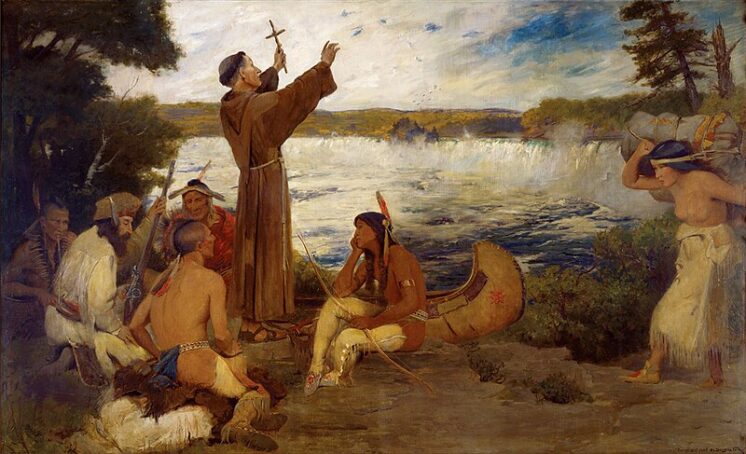
Douglas Volk’s painting “Father Hennepin Discovering the Falls of St. Anthony,” commissioned specifically for the Governor’s Reception Room of the Minnesota State Capitol.
There is also only one account of the rescue, with this part of the story coming from Du Luth. He claimed that he and three other men encountered 200 Dakata warriors, forced them back to their village, and demanded the release of Hennepin and his party. And then he stayed with the Dakota for a month, during which time they helped the Europeans prepare for their departure, including making a map for them, just to make sure they didn’t get lost on their way out. Upon departing, Du Luth made a promise that he would “come to trade again.”
Based on the information contained in their own accounts and the cultural context of the time, Wingerd strongly suggests that there was neither a kidnapping nor a rescue. The story is far more likely one of the Dakota people who Hennepin encountered doing their best to establish a good trading relationship with a group they had heard might have a lot to offer. The lack of a shared language would have made communication difficult, but there’s little reason to give either Hennepin or Du Luth the benefit of the doubt that they simply misinterpreted the intentions of their hosts. La Salle, a contemporary of Du Luth, said of him, “He will not fail to exaggerate everything. It is his character … he speaks more in keeping with what he wishes than what he knows.”
And for a priest, Hennepin told a lot of lies himself. On the English learning site Fraze.it, the first example they give for the word falsifier is a 1913 quote from historian Francis Parkman: “Hennepin has been denounced by many historians and historical critics as an arrant falsifier.” His enormously popular 1683 book, A Description of Louisiana, gave Europeans their first account of the future Minnesota, an account filled with colorful and exaggerated tales of the indigenous people he encountered, tales that sold books by telling a European audience what it wanted to hear. And while the story of his supposed rescue appears nowhere in his books, over time his account and Du Luth’s ended up fused into a single story that became part of the canon of early Minnesota history, a story of the bravery and heroism showed by European explorers facing off against a strange and hostile people.
When retelling these tales, I try to be mindful of the note in the University of Minnesota Duluth’s Land Acknowledgment, “Colonialism is a current ongoing process, and we need to build the mindfulness of our present participation.” I don’t want to inadvertently accept the premise that these must have been men of great significance because significant places are named after them. I hope the distinction is clear here between the significance of a person and the significance of naming something after a person, how that act shapes whose stories get told and how they are told. Du Luth met with a group of indigenous people at the head of the lakes for a few days, and because of that, he has a city named after him along with all the brands and businesses that use that city’s name, including this website. This act of naming has led people like me to tell and retell different parts of his story. The names of the people he met with who lived at the head of the lakes were never recorded; their specific stories remain untold.
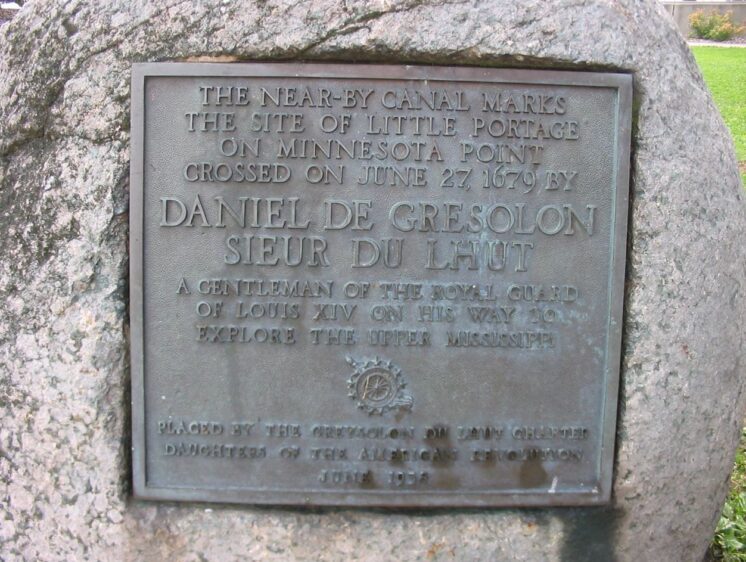
A plaque from 1938 near the Lift Bridge marking where Du Luth may have been in 1679 (Photo by Keith L.)
In the footnotes of the standard textbooks of Minnesota history, the presence of these two men together at the Battle of Seneffe is noted as another marker of their valor, both facing the dangers of battle together in different ways before taking on the dangers of the new continent. But in the context of the historical account told by Wingerd in North Country, the presence of these two prominent Minnesota names at a battle over the borders of France is simply one of the more visible pieces of evidence of the relationship between France and the indigenous groups of the area during the 200-year period when the French referred to it as New France. Wingerd relates how the relationship between these two groups centered primarily on maintaining good trading relationships by maintaining good personal relationships. Marriages between people of French and indigenous ancestry across multiple generations created interconnected bonds of kinship that influenced by both cultures. The story of French colonialism told by Wingerd isn’t one defined by the heroics of a couple of European individuals but a process of cultural exchange and commercial negotiation between two interconnected groups, a process that became increasingly less based on mutual respect when the French left and the British and then the United States arrived.
Without Hennepin or Du Luth, Minnesota history would likely not be all that different, although quite a few of the names within the state would be. Before the townships at the head of the lakes began to merge in the late 19th century, Oneota Township was the largest. If Du Luth had died at the Battle of Seneffe — or been severely injured like the squire he had pledged to protect — I might be writing about the relationship between the Oneota people and ancient city of Cahokia for Perfect Oneota Day. But Du Luth survived and had a city named after him and Hennepin left the battlefield without again contracting spotted fever or getting excessive diarrhea and had the most populous county of Minnesota named after him. These acts of naming were not likely accompanied by any mindfulness of colonial processes, but they did create a specific connection between the state of Minnesota and a small town in southern Belgium, inviting a present day reflection on those processes.
Recommended Links:
Leave a Comment
Only registered members can post a comment , Login / Register Here

















2 Comments
Eric Chandler
about 5 months agoDave B
about 5 months ago